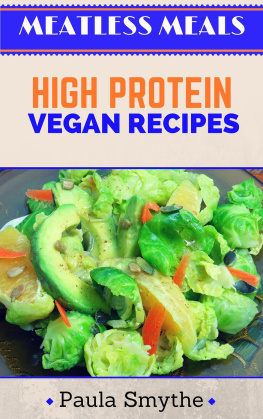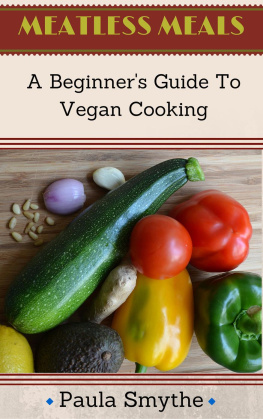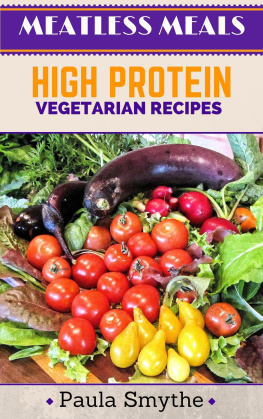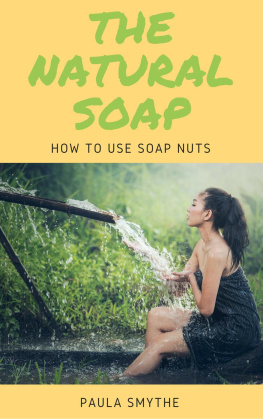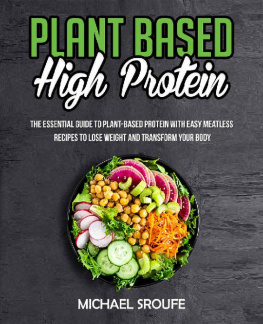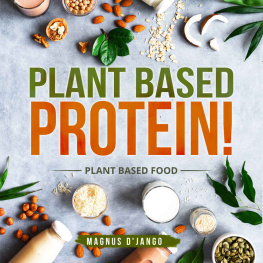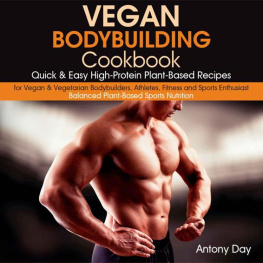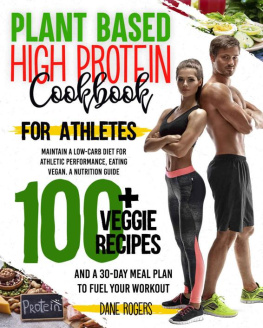Vegan: High Protein Vegan Recipes
While every precaution has been taken in the preparation of this book, the publisher assumes no responsibility for errors or omissions, or for damages resulting from the use of the information contained herein. VEGAN: HIGH PROTEIN VEGAN RECIPES First edition. February 12, 2016. Copyright 2016 Paula Smythe. ISBN: 978-1386676577 Written by Paula Smythe. 10 9 8 7 6 5 4 3 2 1
Also by Paula Smythe Meatless Meals Vegetarian: A Beginner's Guide To Vegetarian Cooking Vegan: A Beginner's Guide to Vegan Cooking Vegan: High Protein Vegan Recipes Vegetarian: High Protein Vegetarian Recipes Plant-Based Protein Guide: High Protein Vegan and Vegetarian Recipes For Athletic Performance and Muscle Growth Plant-Based Starter Kit: Vegan and Vegetarian Recipes For Beginners Standalone The Natural Soap 5 Minute Fudge Machine: Experiments in the Dark Arts of Fast Fudge
"Where do you get your protein?" That's the question you hear when you tell people you've stopped eating meat. And on the surface, it seems like it might be a good question.
However, there's a more important question that should be asked first: "How much protein do you actually need?" My goal with this recipe guide is to help you figure out how much protein you need, where to find it, and then give you some tasty options for meeting your goals. If that sounds like a good plan, proceed and let's get started. There's a little bit of work to do, but we get that out of the way first so that we can have fun - delicious, nom nom goodness type fun - after. **** S o, how much protein do you really need? Chances are good that what you need is lower that what you think you need. The recommended daily intake of protein is .8 grams per kilogram of bodyweight (which equals .36 grams per pound) for average non-elderly non-athletes. If you are elderly, you need more protein - around .5 grams per pound of bodyweight.
What does that mean for you? Well, here's an example: If you're 24 years old and weigh 150 pounds, multiply that 150 by .36, and you see that you should be aiming for 54 grams of protein per day. That's not too bad, right? And if you're an athlete - and by athlete I don't mean your career choice, if you run or lift weights a few times a week you're an athlete - then your needs increase. You have greater tissue repair needs that must be met. A study can be found here: link. If you're an endurance athlete like a runner: 1.2 to 1.4 (kg) = .54 to .63 (lb) If you're a strength athlete like a weightlifter: 1.4 to 1.8 (kg) = .63 to .81 (lb) So if that same 150 pound person is a runner, they need 81 to 94.5 grams of protein per day. If they are a weightlifter, they need 94.5 to 121.5 grams per day.
Those numbers are a bit trickier to obtain, but that's to be expected, since they're athletes. With that in mind, even those numbers don't seem too bad, right? Well, those numbers are strictly about your needs , but there aren't many problems associated with going over those numbers. Yes, if you really overdo it you can run into some big problems, but you can also die from drinking too much water. Take everything in moderation, okay? But let me tell you why you want to eat more protein than the minimum numbers suggest. The number one reason is for weight loss. Eating more protein can increase the amount of calories you burn.
Yes, there's science involved. Increasing your protein to 25-30% (I'll get to the % thing in a minute) of calories consumed can cause you to burn 80-100 more calories a day. That's not a lot, but it adds up over time. More importantly, though, is that eating more protein makes you feel fuller for a longer period of time. So it keeps you from overeating and snacking. Less calories coming in leads to weight loss.
Eating more protein can also help you build and/or maintain muscle mass, too. Muscle burns calories over time, so you'll be able to hold your goal weight easier. And more muscle can help prevent osteoporosis. One more thing: I know I've sort of assumed you know what I'm talking about when I say "1 gram of protein", and I just want to be sure we're on the same page. What I'm talking about is the actual protein IN the food, not the amount of food itself. For instance, 1 cup (172 g) of black beans has 15 grams of protein in it.
Just wanted to clear that up. Now for that % of calories thing, and calculating your needs. Go to a metabolic calculator (here's one) and fill in the form to see what your calorie requirements are. For an example, I put in a 5'5" female, 24 years old, 150 pounds, very active. The calculator tells me that she requires 2512 calories per day to maintain. (2512 * .25) = 628 calories that should be protein.
Since each gram of protein has 4 calories, 628 / 4 = 157 grams of protein per day. You'll notice that the number earlier were much smaller; obviously she is quite the athlete. Now, I'll change only the box that says "very active" to "sedentary". She only requires 1847 calories. (1847 * .25) = 461.75 / 4 = 115 (rounded down). Before going on, find out how much you need.
Don't worry, I don't want you to keep track of your daily intake everyday. You can, if you want, but what I really want you to know is what you should be aiming for. You'll know if you're close when you start seeing results. **** N ow that that's done, where do you find all that pesky protein? Here are some of the best sources of plant-based protein out there: FoodAmountProtein (g) Tempeh1 cup31 Soybeans1 cup29 Seitan3 ounces21 Lentils1 cup18 Black beans1 cup15 Kidney beans1 cup15 Chickpeas1 cup15 Pinto beans1 cup15 Lima beans1 cup15 Black-eyed peas1 cup13 Tofu, firm4 ounces11 Bagel3.5 ounces10 Quinoa1 cup8 Peas1 cup8 Peanut butter2 Tbsp8 Spaghetti1 cup8 Almonds1/4 cup8 Soy milk, plain1 cup7 Almond butter2 Tbsp7 Bulgur1 cup6 Sunflower seeds1/4 cup6 Cashews1/4 cup5 Spinach, cooked1 cup5 Broccoli1 cup4 You'll notice that many of these sources are nuts and seeds and legumes, and the top sources are soy. Although it isn't listed here, these foods differ in their amino acid profiles. You can learn more here (complete protein), but it's enough for you to know that you need to eat a variety of foods, and not just stick to the top of the list.
But you probably eat a variety of food already, so hopefully that's not an issue. Another thing to watch out for is too much soy. There are studies that have shown that a diet that is very high in soy products can lead to health problems. Don't worry too much, but just keep in mind that you need to mix it up. For instance, if you eat a lot of tofu, maybe swap to almond milk instead of soy milk, that way you don't overdo it. I've done my best to provide recipes here for everyone.
Some recipes are gluten-free, some are nut-free. I hope you find something that you fall in love with. And with that, let's get to the fun part - the FOOD! YUMMY! -Paula
Chickpea Sloppy Joes
T hese are not the sloppy joes you grew up with! This grown-up version of the classic comfort food is full of muscle-building protein, and is completely vegan. So don't feel so guilty if you eat more than one. Chickpea Sloppy Joes 1 tablespoon olive oil 1 small onion, diced 2 cloves garlic, minced 1 bell pepper, finely diced 2 (15 oz) cans chickpeas, rinsed and drained 1 (15 oz) can crushed tomatoes 1 (4 oz) can tomato paste 2 tablespoons soy sauce 2 tablespoons Sriracha hot sauce 2 teaspoons dried oregano 1 teaspoon cumin 1 teaspoon dried thyme 1 teaspoon paprika 1 teaspoon Kosher salt 1/2 teaspoon black pepper 8 whole wheat hamburger buns, or Ezekiel buns (9g protein each!) - Heat olive oil in large sauce pan over medium heat. Add onion, garlic, and bell pepper.
Cook until pepper are soft 5-7 minutes. 2 - Add chickpeas to pan and mash with potato masher or fork. You want to mash until you reach the consistency of very chunky peanut butter. 3 - Add crushed tomatoes, tomato paste, soy sauce, Sriracha, oregano, cumin, thyme, paprika, salt, and black pepper to pan and mix well. Cook mixture 15-20 minutes, or until it thickens slightly. 4 - Serve hot on hamburger buns. 4 - Serve hot on hamburger buns.
Next page
